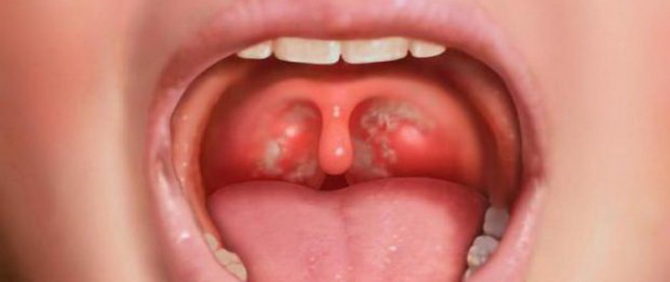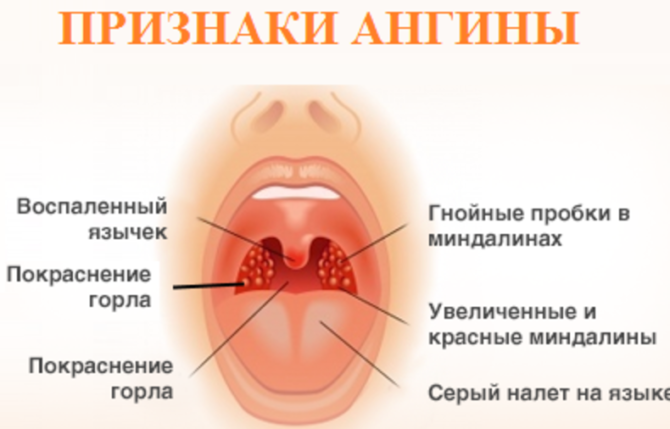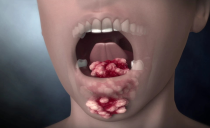White dots on the tonsils and tonsils in the throat in children and adults: causes and treatment
Both in children and in adults white spots on the tonsils indicate an attack of pathogenic microorganisms. Whitish plugs in the gaps of the glands are accumulations of pus consisting of dead immune and epithelial cells, as well as microbes destroyed by immunity. Such formations can have a gray or yellow tint and a purulent smell, which is felt not only by the patient, but also by those around him.
If you find purulent plugs in your throat, you should visit the otolaryngologist as soon as possible, because this symptom may indicate the development of severe infections.
Content
What are the white spots in the throat in children and adults?
White and yellow spots on the glands are a non-specific symptom of inflammation, which is a consequence of the active work of the tonsils. These small organs carry out one of the most important functions of the immune system - providing a barrier to the path of infectious agents to the respiratory system: larynx, bronchi, and lungs.
By catching unicellular pathogenic fungi, pathogenic bacteria and viruses, the glands become inflamed, which is a natural immune response. With increased blood flow, a large number of antibodies and lymphocytes accumulate in them, which tend to overcome the infection in the throat without passing it into the internal organs.
White plaques can appear in the gaps of the glands for non-infectious reasons, so it is impossible to perform an accurate diagnosis only on this basis, especially at home.
White spots in the throat on the tonsils can appear against the background of the following diseases:
- tonsillitis of bacterial origin;
- herpes sore throat;
- tonsillolite;
- diphtheria;
- tonsillomycosis.
Tonsillitis of bacterial origin
Bacterial tonsillitis occupies a leading position in the list of causes of white spots in the throat in children. However, the disease can also occur in adults. The causative agent of the disease are staphylococci or streptococci.
White dots and spots are formed on the glands only with lacunar and follicular tonsillitis. With catarrhal and fibrinous tonsillitis, plaque accumulates on the tonsils in the form of a continuous film.
With tonsillitis, whitish plaques form not only on the mucous membrane of the tonsils, but also on the back of the throat. Due to inflammation, the soft tissues surrounding the glands become red, swollen and painful. The nearby lymph nodes become inflamed and sore, the temperature rises, and weakness is felt.
If pus remains on the surface of the glands for a long time, the immune system weakens, and conditions arise that predispose to the development of chronic tonsillitis.
Herpes sore throat
Herpes sore throat is a viral tonsillitis caused by a herpes infection: the Coxsackie virus. The disease is accompanied by the formation of white dots in the throat and occurs mainly in children. The manifestation of signs of the disease begins with a sharp jump in temperature, intestinal pain and vomiting can occur.
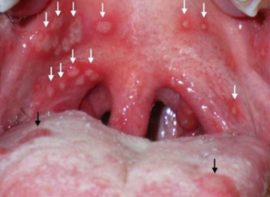 On the first day or the next day after the development of herpes sore throat, the mucous membrane of the throat turns red and becomes covered with small vesicles. After a few days, they burst, in their place there is pus in the form of a point white plaque.In addition, the patient:
On the first day or the next day after the development of herpes sore throat, the mucous membrane of the throat turns red and becomes covered with small vesicles. After a few days, they burst, in their place there is pus in the form of a point white plaque.In addition, the patient:
- sore throat;
- lymph nodes increase;
- the palatine tongue turns red;
- salivation increases.
Due to the similarity of herpes sore throat with other viral diseases, it is difficult to diagnose. Therefore, in addition to the analysis of plaque from the tonsils, a blood test is carried out for the presence of immune substances allocated to fight the Coxsackie virus.
Tonsillolite
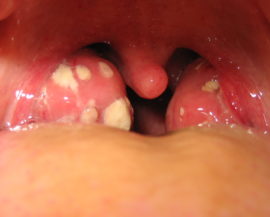 Tonsillolitis is an ailment accompanied by the formation of purulent plugs consisting of food particles, exfoliated epithelium, as well as dead microorganisms and immune cells that remain on the tonsils after respiratory diseases. Such white plaques are called “tonsil stones”. They can have a yellowish or grayish tint, cause bad breath and more often occur in people with chronic respiratory diseases.
Tonsillolitis is an ailment accompanied by the formation of purulent plugs consisting of food particles, exfoliated epithelium, as well as dead microorganisms and immune cells that remain on the tonsils after respiratory diseases. Such white plaques are called “tonsil stones”. They can have a yellowish or grayish tint, cause bad breath and more often occur in people with chronic respiratory diseases.
With tonsillolitis, white dots on the glands are not accompanied by fever and other symptoms.Therefore, you can notice them only by chance.
Diphtheria
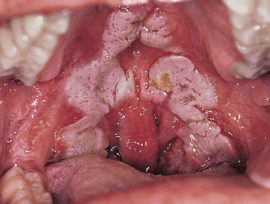 Previously, a diagnosis of diphtheria was common, but today it has become rare due to systematic vaccination. The infectious process caused by Leffler’s bacterium affects the mucous membrane of the oral cavity, causing redness, the appearance of white plaque and swelling of the back of the throat, glands.
Previously, a diagnosis of diphtheria was common, but today it has become rare due to systematic vaccination. The infectious process caused by Leffler’s bacterium affects the mucous membrane of the oral cavity, causing redness, the appearance of white plaque and swelling of the back of the throat, glands.
With diphtheria, not only the tonsils suffer, but also the internal organs: heart, kidneys, brain. Therefore, in addition to sore throat, fever and enlarged lymph nodes, the possible symptoms of the disease include increased heart rate, intoxication, hallucinations, and nephrosis.
Red throat, covered with white dots, and visible violations of the physiological systems of the body are the first symptoms of diphtheria and an urgent reason to seek specialized help.
Tonsillomycosis
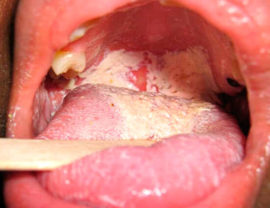 Tonsillomycosis is tonsillitis of fungal origin, one of the manifestations of thrush caused by Candida fungus, which is part of the natural microflora of the oral cavity and does not cause problems with strong immunity. White spots of fungal origin can be found in the throat of adults, but most often this disease manifests itself in newborns and preschool kids.
Tonsillomycosis is tonsillitis of fungal origin, one of the manifestations of thrush caused by Candida fungus, which is part of the natural microflora of the oral cavity and does not cause problems with strong immunity. White spots of fungal origin can be found in the throat of adults, but most often this disease manifests itself in newborns and preschool kids.
With tonsillomycosis, yellow or white curdled formations appear on the surface of the pharynx, tongue, and throat. The mucous membrane below them turns red, swollen and sore. Often, the disease is accompanied by swelling of the lymph nodes and fever. However, tonsillomycosis, accompanied by the appearance of white dots in the throat, can occur without an increase in temperature.
Special symptoms of the disease are a violation of taste perception and an acidic smell from the oral cavity, which is a consequence of the vital activity of fungi.
Treatment of white spots on the tonsils and tonsils in the throat
For any of the ailments described above, it is recommended to rinse the oral cavity with saline, soda, chlorhexidine or furatsilinovoy solution or chamomile or sage broth. This procedure must be carried out frequently and carefully so that pathogenic microbes do not remain in the oral cavity. The effectiveness of rinsing increases regular brushing of teeth and tongue, carried out in the mornings and evenings.
The medications prescribed by the otolaryngologist should be taken, strictly observing the dosage. Refusal from antibiotics, immunomodulators or antiviral drugs leads either to the transition of the acute form of the disease to chronic, or to serious complications.
With illiterate self-medication, microbes from the surface of the tonsils, the walls of the pharynx and palatine tongue can spread throughout the body, causing inflammation of the ears, lungs, brain, and kidneys.
Treatment of bacterial tonsillitis
Purulent sore throat must be treated with antibiotics. Therapy will be effective only if you first investigate the plaque analysis and identify a specific variety of the pathogen.Based on the results of the study, it is possible to select a group of antibacterial agents to which the identified bacteria are most susceptible.
In addition, antipyretic, analgesic drugs and anti-inflammatory drugs of general and local action are prescribed. The plaque must be thoroughly washed off, rinsing the mouth with antiseptic solutions.
Herpes Sore Throat Treatment
When confirming a diagnosis such as herpes sore throat, antiviral, antiallergic and antipyretic drugs, rinses are prescribed. With proper treatment, spots in the throat disappear after about a week, if they remain, you should consult a doctor to adjust the therapeutic course.
How to cure tonsillitis
The surface of the tonsils is cleaned naturally, but if there are traffic jams in their gaps for a long time, you have to resort to conservative therapy. The main goal in the treatment of tonsillitis is the elimination of plaques. This can be done with:
- rinse;
- vacuum cleansing;
- laser removal.
In advanced cases, it is recommended to take an antibacterial course. Some adults sometimes manage to squeeze purulent plugs with cotton buds, but doctors are strongly advised not to resort to such manipulations, especially with regard to children. With inaccurate actions, you can injure the palatine tongue, tonsils, the back of the throat and provoke an infectious inflammation.
How to treat diphtheria
Diphtheria is recommended to be treated in a hospital, so patients are hospitalized at the first suspicion of this diagnosis, detected with the help of bacteriosis or PCR tests. Antibiotics with this infection are ineffective, a person’s life can be saved only with the help of a special antitoxin.
In addition, therapy is carried out aimed at eliminating intoxication and reducing the negative impact on vital organs. Hormones are sometimes used, mouth rinses with antiseptics are prescribed.
Tonsillomycosis Treatment
Eliminate the white dots that have formed on the back of the throat with tonsillomycosis can only be done through complex treatment. An effective antifungal drug is best chosen after accurately determining the variety of the pathogen.
In addition to antifungal therapy, the following are involved:
- To reduce pain, anesthetizing sprays are used.
- Cottage cheese plaque is washed off with antiseptic solutions.
- With an increase in temperature, antipyretic drugs are taken.
An important component of therapy for tonsillomycosis is the strengthening of immunity by correcting nutrition or using special multivitamins and immunomodulators.
To prevent the appearance of white spots on the tonsils, you should strengthen your body with all available methods. The glands of a healthy person cope with the infection quickly, without the accumulation of purulent plaque.

